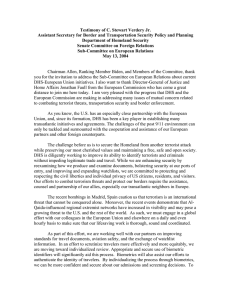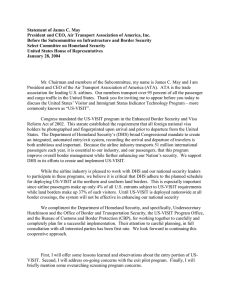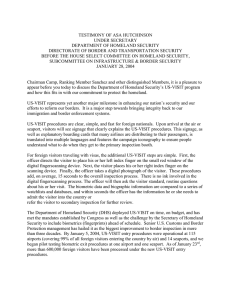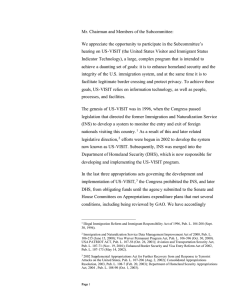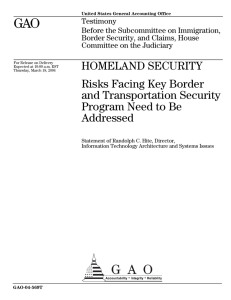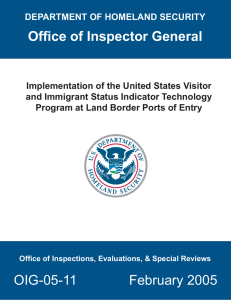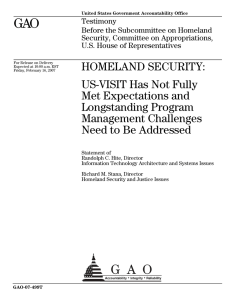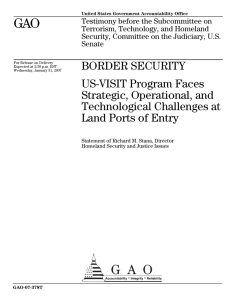TESTIMONY OF TOM RIDGE SECRETARY DEPARTMENT OF HOMELAND SECURITY
advertisement
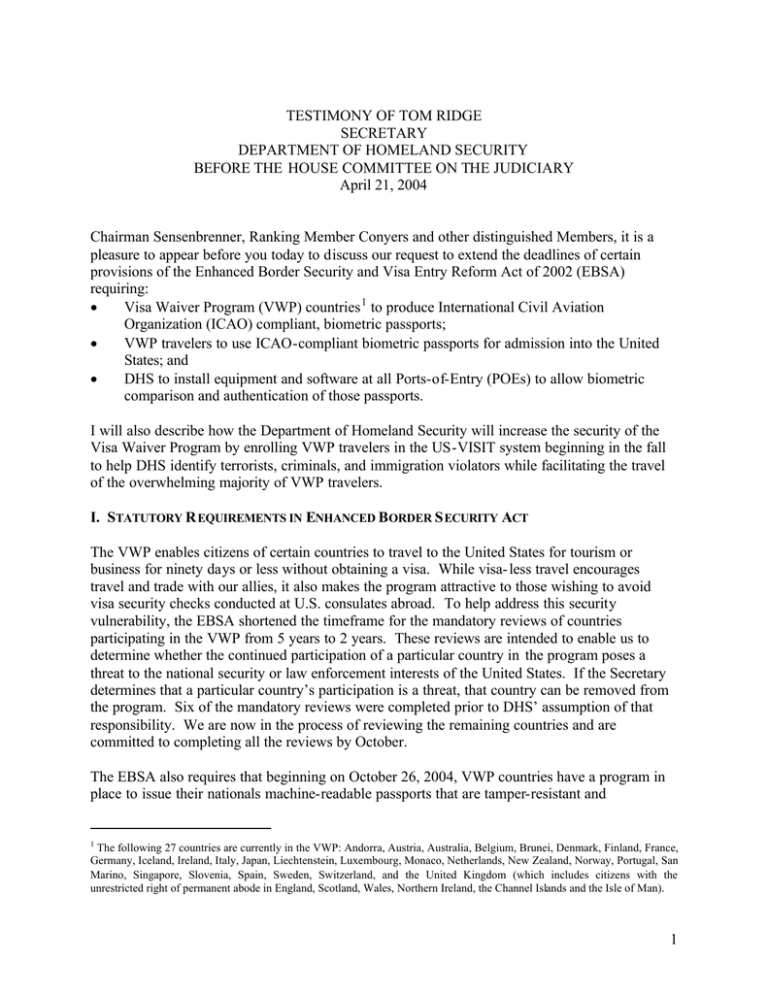
TESTIMONY OF TOM RIDGE SECRETARY DEPARTMENT OF HOMELAND SECURITY BEFORE THE HOUSE COMMITTEE ON THE JUDICIARY April 21, 2004 Chairman Sensenbrenner, Ranking Member Conyers and other distinguished Members, it is a pleasure to appear before you today to discuss our request to extend the deadlines of certain provisions of the Enhanced Border Security and Visa Entry Reform Act of 2002 (EBSA) requiring: • Visa Waiver Program (VWP) countries 1 to produce International Civil Aviation Organization (ICAO) compliant, biometric passports; • VWP travelers to use ICAO-compliant biometric passports for admission into the United States; and • DHS to install equipment and software at all Ports-of-Entry (POEs) to allow biometric comparison and authentication of those passports. I will also describe how the Department of Homeland Security will increase the security of the Visa Waiver Program by enrolling VWP travelers in the US-VISIT system beginning in the fall to help DHS identify terrorists, criminals, and immigration violators while facilitating the travel of the overwhelming majority of VWP travelers. I. STATUTORY R EQUIREMENTS IN ENHANCED BORDER S ECURITY ACT The VWP enables citizens of certain countries to travel to the United States for tourism or business for ninety days or less without obtaining a visa. While visa- less travel encourages travel and trade with our allies, it also makes the program attractive to those wishing to avoid visa security checks conducted at U.S. consulates abroad. To help address this security vulnerability, the EBSA shortened the timeframe for the mandatory reviews of countries participating in the VWP from 5 years to 2 years. These reviews are intended to enable us to determine whether the continued participation of a particular country in the program poses a threat to the national security or law enforcement interests of the United States. If the Secretary determines that a particular country’s participation is a threat, that country can be removed from the program. Six of the mandatory reviews were completed prior to DHS’ assumption of that responsibility. We are now in the process of reviewing the remaining countries and are committed to completing all the reviews by October. The EBSA also requires that beginning on October 26, 2004, VWP countries have a program in place to issue their nationals machine-readable passports that are tamper-resistant and 1 The following 27 countries are currently in the VWP: Andorra, Austria, Australia, Belgium, Brunei, Denmark, Finland, France, Germany, Iceland, Ireland, Italy, Japan, Liechtenstein, Luxembourg, Monaco, Netherlands, New Zealand, Norway, Portugal, San Marino, Singapore, Slovenia, Spain, Sweden, Switzerland, and the United Kingdom (which includes citizens with the unrestricted right of permanent abode in England, Scotland, Wales, Northern Ireland, the Channel Islands and the Isle of Man). 1 incorporate biometric and document authentication identifiers that comply with ICAO standards as a condition of continued participation in the VWP program. The law also requires that visitors coming to the United States under the VWP present machine-readable, tamper-resistant passports that incorporate biometric and document authentication identifiers, if the passport is issued on or after October 26, 2004. Furthermore, DHS is required to install equipment and software at all ports of entry to allow biometric comparison and authentication of these passports. While most VWP program countries will be able to certify that they have a program in place to issue biometric passports by the October deadline, very few, if any, VWP countries will actually be able to begin issuing biometric passports by that date. The result is that millions of visitors from VWP countries who are issued non-ICAO compliant passports after October 26, 2004, will be required to obtain visas prior to traveling to the United States. The issue is not lack of will or commitment to achieving the standard by these countries, but rather challenging scientific and technical issues. The ICAO selected contactless integrated-circuit chips for data storage, and stated that if biometrics are incorporated into the travel document, the mandatory biometric is the “encoded face.”2 Last week, ICAO published a revision to the standard to address the issue that, up to this point, the standard did not ensure that all chips produced for incorporation into passports can be read by any reader and any reader produced to that standard can read any chip. This standard will be approved in May. 3 Both DHS and the Department of State (DOS) are encouraged by the progress that has been made by VWP countries to meet the emerging ICAO standards and will work with them to meet the deadlines. For the same challenging technical reasons, DHS is also not currently in a position to acquire and deploy equipment and software to biometrically compare and authenticate these documents. DHS cannot today acquire one reader that will be able to read all chips utilized in the ICAO compliant biometric passports. However, we believe that by the fall of 2006, the technology required to implement successfully a security system based on the ICAO standards will be much more settled and allow DHS to derive the security benefits envisioned when the original EBSA was enacted. Acknowledging the current state of technology, and the potential for harm to our international relations with our closest allies, DHS and DOS are requesting that the October 26, 2004, deadline be extended to November 30, 2006, for those sections of the EBSA relating to the production of ICAO-compliant biometric passports, and deployment of equipment and software to read them. 2 Machine Readable Travel Documents: Technical Report: Development of a Logical Data Structure - LDS for Optional Capacity Expansion Technologies, ICAO, April 2004. The report states: "While the use of biometrics is optional for issuing authorities, if a choice is made to incorporate biometrics, Data Group 2, the encoded face, is therefore Mandatory. All other Data Elements defined for recording by an issuing State or organization are optional. " 3 The Machine Readable Travel Documents: Technical Report: Development of a Logical Data Structure - LDS for Optional Capacity Expansion Technologies, ICAO, April 2004, report will be approved at the Technical Advisory Group in Montreal, Canada in May 2004. 2 Based on the information provided to us by these countries on their status and their expected implementation dates, as well as DOS’s own experience as it moves to implement this standard for U.S. Passports, we believe that all countries will be compliant by the November 30, 2006, deadline. II. INCREASING S ECURITY THROUGH US-VISIT EXPANSION While we recognize the need to extend the date for these new processes, we are focused on the need to continue to increase security at the borders. Therefore, we will expand US-VISIT procedures to visitors traveling under the VWP at: • Air and sea POEs by September 30, 2004, • The most trafficked land POEs by December 31, 2004, and • The remaining land POEs by December 31, 2005. 4 In FY 2003, DHS recorded the admission of approximately 13 million VWP travelers through air and sea POEs. This number includes multiple visits to the U.S. by a single individual. By expanding US-VISIT to include processing of VWP travelers, DHS will double the number of admissions processed through US-VISIT from its current status. As discussed below, we are confident that the US-VISIT infrastructure can continue to function quickly and accurately after the expansion. In addition, while the number of VWP travelers arriving at land ports of entry is small, the expansion rollout plan will allow for biometric enrollment for those travelers as well. DHS believes that processing visitors traveling under VWP in US-VISIT achieves several important security objectives. These security objectives include: • Conducting appropriate security checks: We will conduct checks of VWP visitors against appropriate lookout databases available to inspectors, adding additional biometric-based checks available through US-VISIT. • Freezing identity of traveler: We will biometrically enroll visitors in US-VISIT – freezing the identity of the traveler and tying that identity to the travel document presented. • Matching traveler identity and document : We will biometrically match that identity and document if a traveler returns to the United States, enabling the inspector to determine whether the traveler complied with the terms of his or her previous admission and is using the same identity. • Documenting arrival and departure: We will collect automated arrival and departure information on travelers. We will update their record to reflect changes in their immigration status while they are in the U.S. • Determining overstays : We will use collected information to determine whether individuals have overstayed the terms of their admission. This information will be used to determine whether an individual should be apprehended or whether the individual should be allowed to enter the U.S. upon his or her next visit. 4 The Immigration and Naturalization Service Data Management Improvement Act (DMIA) of 2000 established a series of deadlines for the implementation a data system that would record arrival and departure information on non-United States Citizens. 3 • Identifying security threats: We will use appropriate security checks to determine individuals who represent a security threat and act upon this information. We believe that the VWP countries will be supportive of this change. To date, response to our announcement of this change from VWP countries has been positive. These countries appreciate both the U.S. interest in increasing security, and our support for an extension to the ICAO comp liant biometric passport requirement. Although the majority of travelers from VWP countries are exempt from the requirement to obtain a nonimmigrant visa, those who are required to obtain one are already successfully processed through US-VISIT. Since the implementation of US-VISIT through April 8, 2004, approximately 400,000 nonimmigrant visa holders from VWP countries have been processed through US-VISIT. Many of the VWP countries themselves are actively engaged in developing programs like USVISIT that allow them to collect biometrics through the visa issuance process and match those biometrics upon entry into the country. We are actively working with many of these countries to share information about terrorism, other security threats, and opportunities for improvements in immigration and border management. In order to expand US-VISIT to VWP travelers, DHS will have to implement both technical and procedural changes. In terms of technical changes, DHS will need to invest in additional hardware and software, including additional biometric matchers, database capacity, processing power, and backup/storage capability, that will support the additional volume and maintain the response times needed on biometric watch list checks and identity matching. DHS will also modify processing procedures and make other operating environment changes to accommodate the increase. These changes will vary in scope, depending on the volume of VWP travelers at that location. III. US-VISIT I MPLEMENTATION AND S UCCESS TO DATE DHS has established US-VISIT to achieve the following goals: • Enhance the safety of our citizens and visitors; • Facilitate legitimate travel and trade; • Ensure the integrity of our immigration system; and • Protect the privacy of travelers to the United States. US-VISIT is a continuum of security measures that begins before individuals enter the United States and continues through their arrival and departure from the country. Using biometrics such as digital, inkless fingerscans and digital photographs, DHS is able to determine whether the person applying for entry to the United States is the same person who was issued the visa by DOS. Additionally, DOS and DHS use biometric and biographic data to check against appropriate lookout data, improving DOS’s ability to make visa determinations and DHS’s ability to make admissibility decisions at entry. US-VISIT procedures are clear, simple, and fast for visitors. 4 DHS deployed the first increment of US-VISIT on time, within budget, and has exceeded the mandate established by Congress as it includes biometrics ahead of schedule. On January 5, 2004, US-VISIT entry procedures were operational at 115 airports (covering 99% of air travelers who use visas to enter the United States) and 14 seaports. In addition, we began pilot testing biometric exit procedures at one airport and one seaport. As of April 20, more than 3 million foreign visitors have been processed under the US-VISIT entry procedures. On average, USVISIT takes only 15 seconds during the inspection process. Already US-VISIT has matched over 259 persons against criminal databases and prevented more than 124 known or suspected criminals from entering the country. One hundred and fifty-eight people were matched while applying for a visa at a State Department post overseas. Our border management system impacts the security of our citizens and our visitors, affects billions of dollars in trade and travel and helps define relations with our international partners. There is a need to improve this system and bring it into the 21st century with a new integrated system of technological processes that will keep our country’s economic and national security strong. This 21 st century technology will provide an important step toward achieving the President’s goal of secure U.S. borders. We respect our visitors’ privacy and seek to enable them to pass through inspection quickly so they can enjoy their visit in our country. However, as people attempt to enter the United States, we must know who they are and whether they intend to do us harm. The ability of US-VISIT to rapidly screen applicants’ biometrics and biographic information through watch lists and databases means we can have security and control without impeding legitimate travelers, and we can also help protect our welcomed visitors by drastically reducing the possibility of identity theft. Moreover, as visitors leave the country, we must know that they have not overstayed the terms of their admission. US-VISIT will be rolled out in increments to ensure that the foundation is strong and the building blocks are effective. With the deployment of the entry components at air and seaports, we have made a strong beginning. We are on track to meet the December 31, 2004, deadline to integrate US-VISIT procedures at the 50 busiest land border ports of entry. US-VISIT is dedicated to safeguarding the privacy of traveler information. US-VISIT has extended the principles and protections of the 1974 Privacy Act5 to all individuals processed through the program – even though the law only applies to U.S. Citizens and Lawful Permanent Residents. US-VISIT has implemented a privacy program that includes a privacy policy6 and a three-stage process for redress, 7 if individuals have concerns about their information. 5 The principles and protections of the Privacy Act are centered around notice to those who will be subject to information collection; notice of how the information will be used and how long it will be retained; and adherence to those uses. 6 The US-VISIT Privacy Policy and Privacy Impact Assessment (PIA) can be found at: http://www.dhs.gov/dhspublic/interapp/editorial/editorial_0333.xml 7 US-VISIT has implemented a three-stage process for redress if an individual has a concern. If an affected individual requests a change or when a DHS Officer determines that an inaccuracy exists in the individual’s record, the DHS Officer can modify the 5 A. Moving to a “Virtual Border” Solution The vision of US-VISIT is to deploy an end-to-end border management program. This comprehensive view of border management leads to a virtual border. It elevates the requirement to develop the best processes to mana ge data on visitors. It will provide information to the immigration and border management decision makers to support the pre-entry, entry, status management, exit and analysis processes. Much of the emphasis to date has focused specifically on the entry and exit processes at the ports of entry – the “port-centric” solution. One of the key initiatives of the US-VISIT program is to adjust this focus to a “virtual border” solution, placing equal emphasis on the pre-entry, entry, status management, exit, and analysis processes associated with this Program. The virtual border will enhance national security by matching the identity of visitors, facilitate legitimate trade and travel, and ensure the integrity of our immigration system by improving enforcement. 1. Pre-Entry For millions of visitors, entry into the United States must be preceded by the issuance of travel documents at a U.S. embassy or consulate abroad. The purpose of the pre-entry process is to determine eligibility for immigration status and/or visas at DOS consular offices worldwide or DHS Service Centers. The pre-entry process is a critical component of the US-VISIT virtual border. The consular officers gather a large amount of information prior to a visitor’s arrival at a port. This data is now available to appropriate border management age ncies. In turn, the US-VISIT Program can provide additional information about the individual, including a history of prior entries and exits, biometrics, or prior immigration status information, that can be used to match identity or search watch lists to the consular officer or Citizenship and Immigration Services adjudicator who is determining a visitor’s eligibility. Since the beginning of 2004, the pre-entry process includes analysis of the manifest supplied by the airlines for each international flight to determine the nonimmigrant visa holders on board the plane. This is done through the Advanced Passenger Information System (APIS). The U.S. Customs and Border Protection Officers analyze this information to know in advance whether a visitor may require additional review at inspection. 2. Entry Process The purpose of the entry process is to determine the admissibility of visitors requesting entry into the United States at air, land, or seaports. The entry process can begin at a primary port inspection booth at an air, sea, or land ports, or at a temporary inspection location such as a ship record. If an individual is not satisfied with this response, he or she can contact the US-VISIT Privacy Officer and ask for assistance. The individual can request a review by the DHS Privacy Officer, to address any remaining concerns. 6 lounge. Visitors can also be inspected at certain pre- inspection locations overseas, such as Shannon Airport in Ireland. As part of the US-VISIT entry process, visitors will be required to provide biometric data, biographic data, and/or other documentation. This data is used to match identity, determine proper visa classification, and to query the watch list. Inspectors match identity of each visitor collected by DOS and determine the visitor’s admissibility. All ports share similarities in the inspection processes. Inspectors must quickly conduct a primary inspection and determine if the applicant should be recommended for a more in-depth review at the secondary inspection point. The average primary inspection of U.S. citizens, lawful permanent residents, and visitors, lasts approximately one minute. Although all inspections involve certain basic tasks, there are marked differences between an inspection conducted at an air or sea port and one conducted at a land port because of the different physical environment and different travel patterns. To expedite the flow of traffic at land ports, DHS has implemented several programs, such as the Secure Electronic Network for Traveler’s Rapid Inspection (SENTRI) or Dedicated Commuter Lane, and NEXUS, using Radio Frequency (RF) technologies to be able to preposition and collect information for inspection. For land borders, we are considering expanded use of RF technology to expedite processing of frequent border crossers using biographical data as part of the virtual border solution. 3. Status Management Includes Identifying Overstays Managing the status of visitors once inside the borders of the United States includes, but is not limited to: • Ensuring that determinations relating to a visitor’s legal extension of stay or change of immigration status are informed by previous determinations by State at visa issuance, DHS when the individual was admitted, or the individual’s compliance on previous visits to the United States. • Updating an individual’s admission record to reflect changes in immigration status or extensions of their period of admission. • Matching arrival and departure records to determine if individuals have overstayed the terms of their admission. • Identifying violations of terms of admission. • Referring lookout or other information demonstrating an individual’s failure to comply with his or her immigration status to agencies and organizations responsible for enforcement. Maintaining the status of visitors while in the United States is an integral part of border management and ensures the integrity of the immigration system. One of the US-VISIT Program’s primary roles in status management will be the overstay calculation, and exchanging appropriate entry and exit information with case management systems, especially those managed by U.S. Citizenship and Immigration Services. 7 4. The Exit Process Will Capture Departure Information Currently, our exit procedures are based upon departure information from passenger manifests shared with us by carriers. We match this information with the admission information and identify those likely to have overstayed the terms of their admission. Our goal is to enhance our ability to match arrivals and departures by using biometrics. We are testing this with various pilot programs, one of them being at the Baltimore-Washington International Airport. We plan to expand our pilot program to a total of 15 air and seaports over the next several months. We will pilot test three options and evaluate the results to identify the best, most efficient and effective process. These pilot programs will build on the current kiosk pilot and test mobile devices. 5. The Analysis of Information The purpose of the analysis process is to provide information that will aid immigration and border management officials in their decision- making process. Currently, the Arrival/Departure Information System (ADIS) system is the primary data source for use in these analyses. One of the activities conducted in the analysis process is the determination of those who have overstayed the terms of their admission. Each week, the Immigration and Customs Enforcement (ICE) Compliance Enforcement Unit (CEU) receives a report of those individuals for whom the period of admission has expired and no departure record has been received. The ICE/CEU evaluates these records, determines whether additional information may exist that would indicate that the person has departed timely or is in a status that would result in their continued presence within the U.S., and acts on the remainder in a manner appropriate to the circumstances. A visitor’s information is stored and routinely updated in ADIS. Information compiled in ADIS will tell the officer if an individual has complied with the terms of his or her admission. If the traveler’s history illustrates immigration violations, the officer would use that information to inform his or her decision. As the US-VISIT program evolves, this process will take on an ever-increasing level of importance. Emphasis will be placed on providing an increased level of information to all border management personnel (e.g., the consular official, the inspector, the adjudicator, and the investigative officer) to aid them in making critical decisions. 6. Watch Lists At various points in the pre-entry, entry, status management, and analysis processes, decision makers are supported by systems checks against data consolidated from law enforcement and intelligence sources that identify persons of interest for various violations. All names and fingerscans are checked against watch lists to identify known or suspected terrorists, criminals, and immigration violators. Terrorist watch list checks are coordinated through the Terrorist Screening Center (TSC). 8 B. The Success Stories of US-VISIT Through the US-VISIT biometric process, DHS and DOS have identified many individuals who are the subjects of lookout records. These included rapists, drug traffickers, and those who have committed immigration offenses or visa fraud. Here are details of a few examples. • Interception of Drug Trafficker who escaped from Prison – On January 14, 2004, at Miami International Airport, a man was identified as wanted by the U.S. Marshals for escaping from La Tuna Federal Correction Facility where he had been serving a sentence for a conviction of dealing cocaine. The individual was turned over to the U.S. Marshals. • Visa Fraud Uncovered – On January 14, 2004, Customs and Border Protection determined that a woman was trying to enter the United States using a false name, after determining that the woman was not the same individual whose visa photo appeared in the database. The traveler was a woman who had been arrested in April 2000 in New Orleans, convicted of passport fraud, placed on 5 years probation, and prohibited from entering the United States during that time. The woman was removed from the United States after it was determined that she did not meet the guidelines for criminal prosecution. • Convicted Sexual Offender Identified – In New York City, on February 19, 2004, USVISIT identified an individual who had a prior conviction for having sex with a minor in 2000, was registered as a convicted sex offender, and was removed from the United States in 2001 as an aggravated felon. He was given an expedited removal and a 20- year ban on re-entry after it was determined that he did not meet the guidelines for criminal prosecution. • Rape Suspect Caught - On February 22, 2004, at Miami International Airport, biographic and US-VISIT biometric checks alerted officers to an active warrant from New York City for rape. Criminal history checks also uncovered 3 prior convictions for possession or sale of marijuana in 1994 and 1995, as well as a 1998 rape arrest. He was turned over to Miami- Dade police for extradition to New York. US-VISIT is critical to our national security as well as our economic security, and its implementation is already making a significant contribution to the efforts of DHS to provide a safer and more secure America. We recognize that we have a long way still to go. We will build upon the initial framework and solid foundation to ensure that we continue to meet our goals to enhance the security of our citizens and visitors while facilitating travel for the millions of visitors we welcome each year. We want to emphasize that we continue to be a welcoming nation, a nation that invites visitors to study, do business, and enjoy our country. We also owe it to our citizens and visitors to deny entry to persons wishing to do harm to the United States. 9 We are committed to building a program that enhances the integrity of our immigration system by catching the few and expediting the many, the United States is leading the way in this new era – keeping our doors open and our nation secure. IV. Conclusion Countries in the VWP are our closest allies and economic partners. Seeking a two-year extension of the October 26, 2004 biometric deadline permits citizens of our allies to travel to the United States without undue burden or delay, while processing VWP travelers through USVISIT allows DHS to achieve our security objective and facilitate the flow of legitimate travelers. 10
